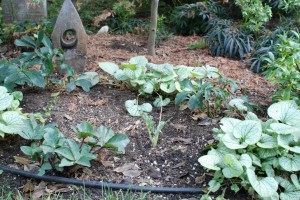by Caroline
I grew up in a little town (it calls itself a village, and while I find the word a little precious, it fits) of big, pretty houses on smallish lawns. The yards weren’t fenced, and my neighborhood didn’t have sidewalks, which made it a pretty soft place for a kid to grow up running around with her friends, racing from one yard to the next as our game developed. Our yard was part of the action, too, until my dad realized that the front got a lot more direct sun than the backyard, and so that’s where the vegetable garden went. Screened by a pretty hedge of deep pink and white beach roses, the garden produced peas, beans, tomatoes, broccoli and lettuce, among other vegetables. My dad established another small garden next to the side door and encouraged a patch of blackberries at the end of the driveway. Volunteer squash and tomatoes sprang up from the compost pile and, as my siblings and I grew up and needed less yard to play in, Dad cultivated gradually larger swaths of the backyard, too.
Now my parents have retired to a big piece of property in rural Connecticut, where my dad has an enormous garden and orchard, and I’m the one with an urban garden. Now, this is not the kind of really urban gardening that Lisa wrote about last summer. We don’t have a front yard here in San Francisco, but we can at least do our planting in the ground, not a truck (though honestly, my kids would prefer a truck).
For now, while my children are young and require a lot of my attention for their cultivation, we’re keeping the garden small. (A friend, whose youngest child is the age of my oldest, has recently converted her entire backyard into an edible space; no lawn at all, just paths made and lined with herbs, blueberry bushes and fruit trees in sunny spots along the fences, vegetables — some in beds, some (like the artichokes) standing alone — sprouting up in every spare nook. I dream of such a yard, someday). We’re still learning what we can
produce here in our foggy neighborhood; we don’t get a lot of heat or sun, but we have a pretty long growing season; greens do very well, tomatoes do not. And whenever one of my kids has an urge to plant a seed, I encourage the impulse even if I know, as with yesterday’s apple seed, it’s not likely to bear edible fruit. Some times, it’s important simply to plant a seed.





Sabrina Fies
November 25, 2009 @ 2:54 am
Hi my name is Sabrina. I was surfing and found your blog, which I liked very much, which is quite pleasant to read. I return next week to read you again. Greetings Sabrina